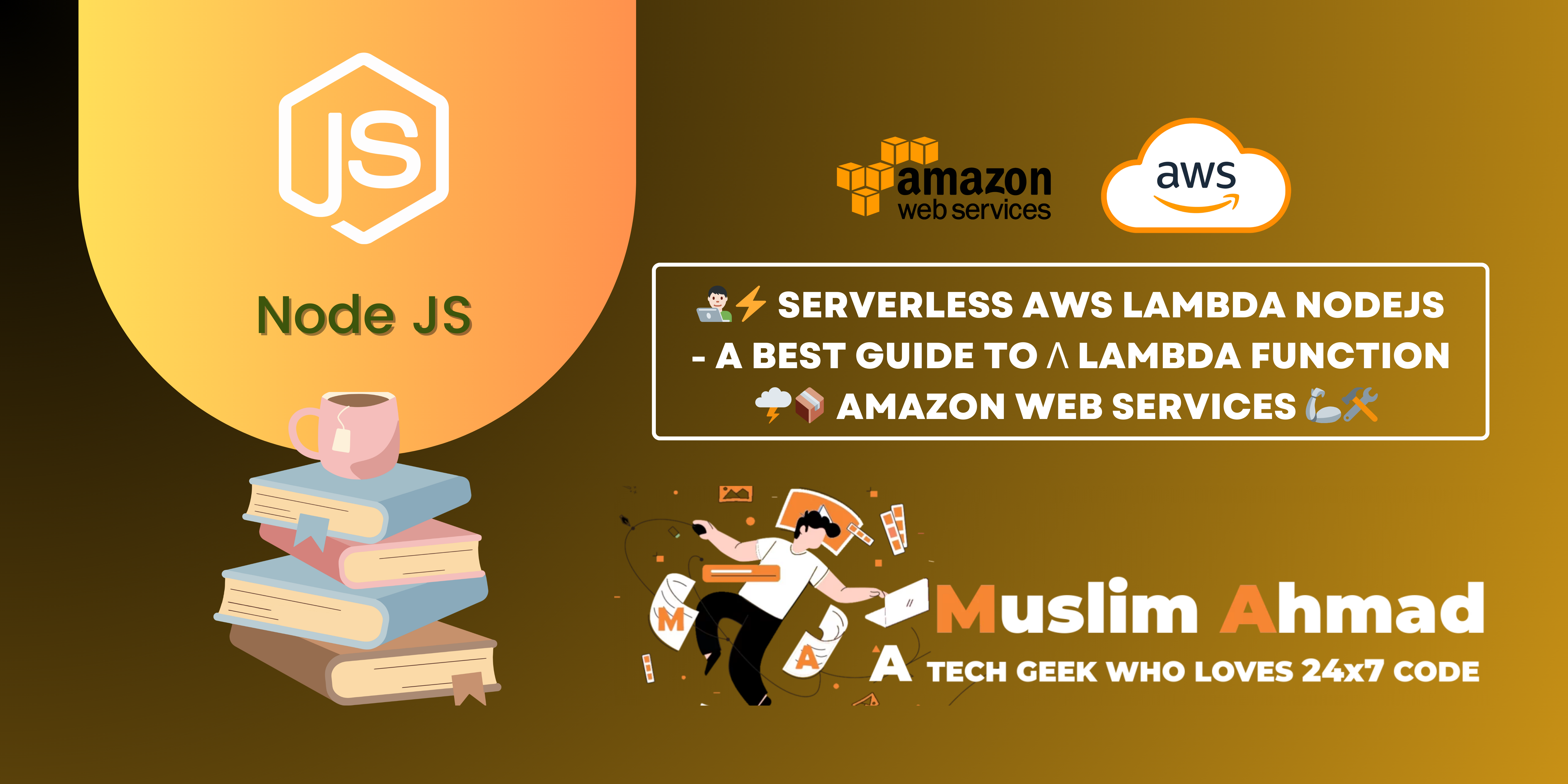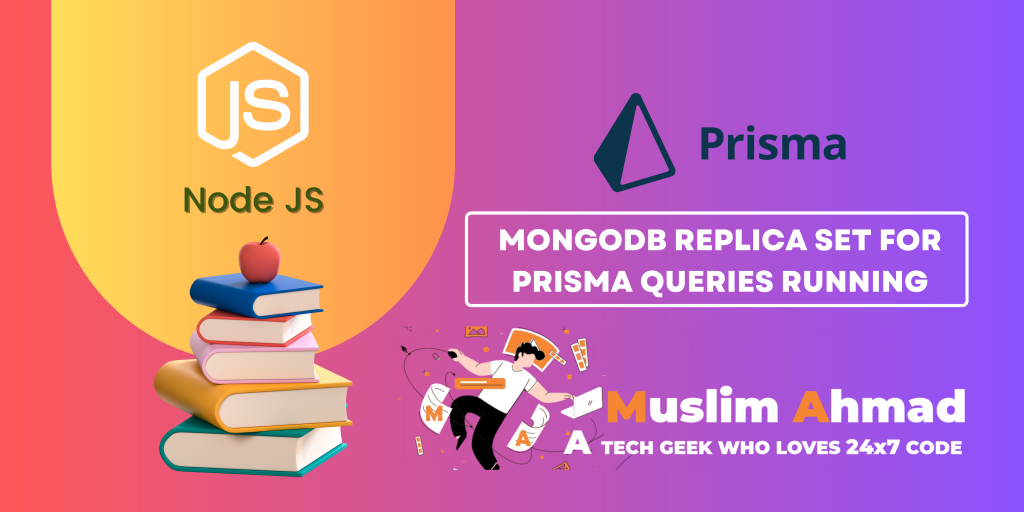In this blog, we will explore “👨🏻💻⚡ Serverless AWS Lambda NodeJS – A Best Guide to λ Lambda Function 🌩️📦 Amazon Web Services 🦾🛠️”. Here, this blog covers all topics like What is AWS Lambda?, Exploring AWS Lambda Function Use Cases, Setting Up AWS Lambda with Node.js and many other things. Let’s dive in and check it out:
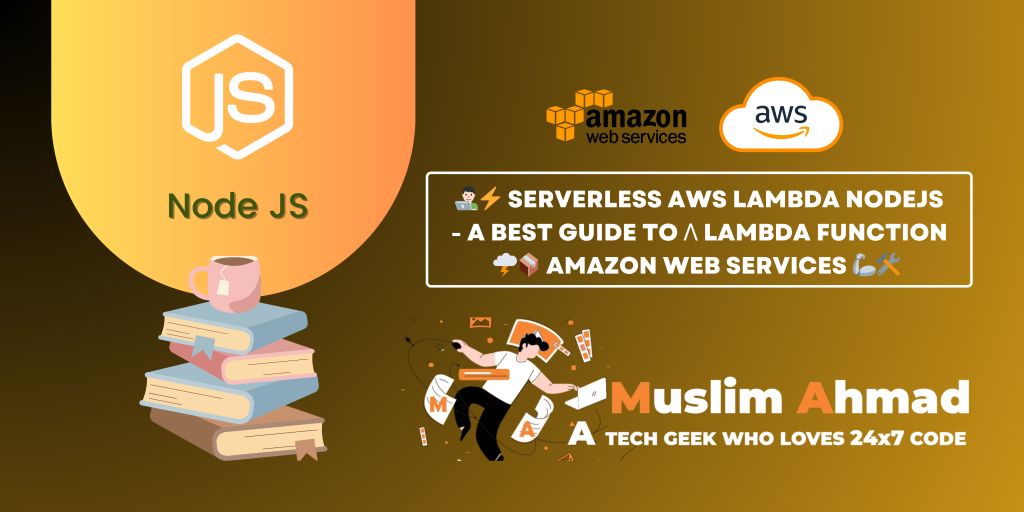
Introduction
Amazon Web Services (AWS) Lambda is a serverless compute service that lets you run code without provisioning or managing servers. Lambda executes your code only when needed and scales automatically, from a few requests per day to thousands per second. This guide will walk you through the essentials of AWS Lambda, helping you understand how it works and how you can leverage it to build scalable, cost-efficient applications.
In the evolving world of cloud computing, AWS Lambda stands out as a revolutionary service that enables developers to run code without provisioning or managing servers. Leveraging Node.js for AWS Lambda functions can enhance your development process due to Node.js’s asynchronous nature and robust ecosystem. This guide will provide an in-depth look at using AWS Lambda with Node.js, from basic setup to best practices.
What is AWS Lambda?
AWS Lambda is a serverless compute service that automatically scales applications by running code in response to triggers from other AWS services or HTTP requests via API Gateway. This eliminates the need for traditional server management, offering a cost-effective and highly scalable solution.
Key Features
- Event-Driven Execution: Lambda functions can be triggered by various AWS services like API Gateways, S3, DynamoDB, Kinesis, SNS, CloudWatch, and more.
- Automatic Scaling: Lambda automatically scales your application by running code in response to each trigger.
- Cost-Effective: You only pay for the compute time you consume, making it a cost-efficient solution.
- No Servers to Manage: Lambda abstracts the infrastructure management, letting you focus on your code.
Exploring AWS Lambda Function Use Cases:
AWS Lambda functions are versatile and can be applied across a wide range of scenarios. From real-time data processing to automation, Lambda functions enable developers to build scalable, efficient, and cost-effective solutions. Below are detailed use cases to help you understand how AWS Lambda can be leveraged in various applications.
There are so many big companies which are customers of AWS Lambda in the world like AutoDesk, NationalWideChildrens, LibertyMutual, TacoBell, etc. (more details).
Setting Up AWS Lambda with Node.js
Prerequisites
- An AWS account – If you don’t have any account yet then create one aws account: click here
- Basic knowledge of Node.js and JavaScript
- Install the POSTMAN app on your operating system or use Postman Web in your browser.
Step 1: Create a Lambda Function
- Log in to AWS Management Console: Navigate to the AWS Management Console and select the Lambda service.
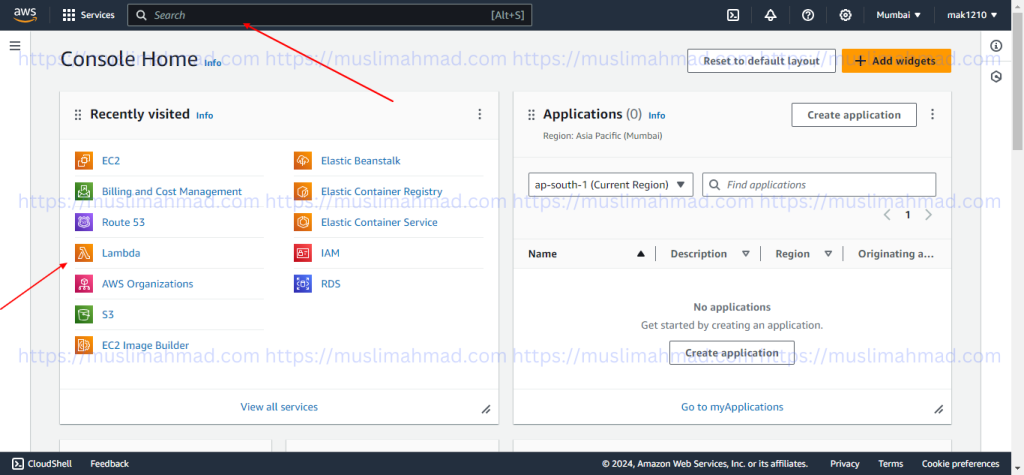
You can click on “Lambda” in the “Recently visited” widget after logging into your AWS account, or you can search for “Lambda” in the search tab.
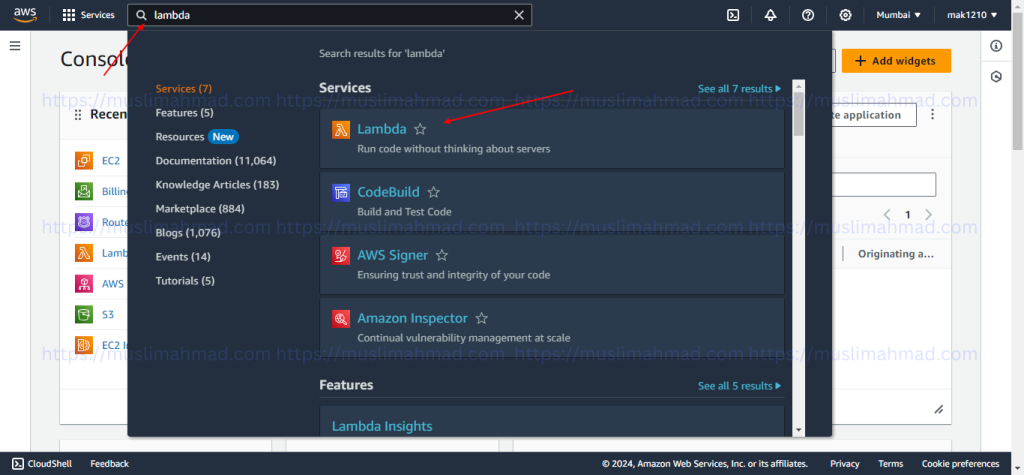
- Create a New Function:
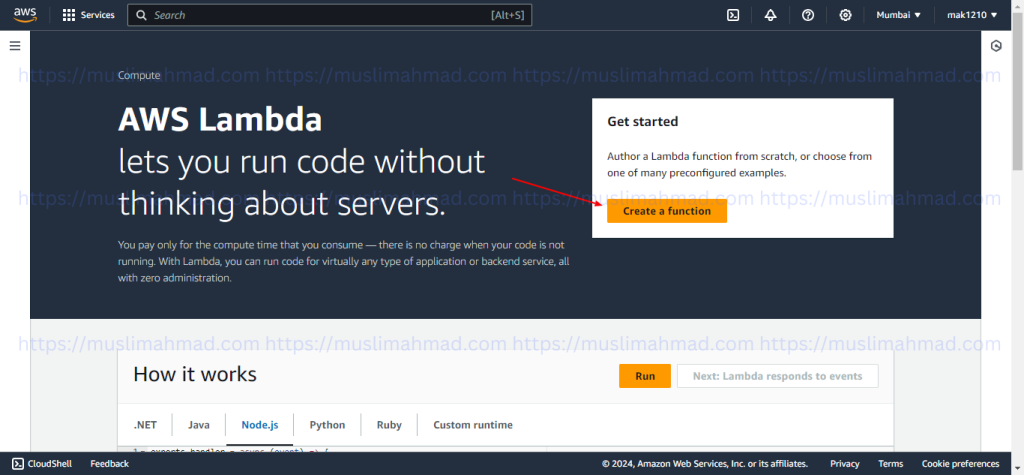
Click on “Create a function” to proceed with the next steps. Alternatively, you can check the code execution examples for Node.js or other programming languages like Java, .NET C#, Python, etc., in the image below:
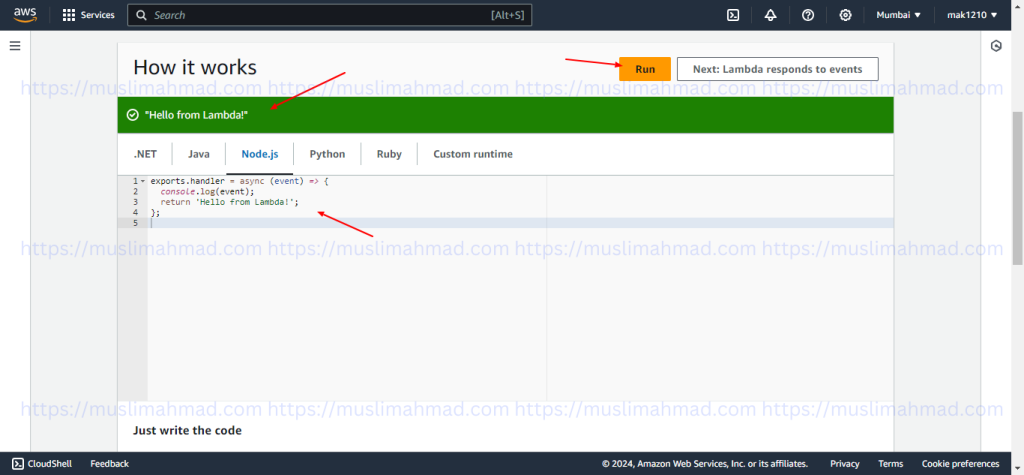
The image below shows the options for creating a function:
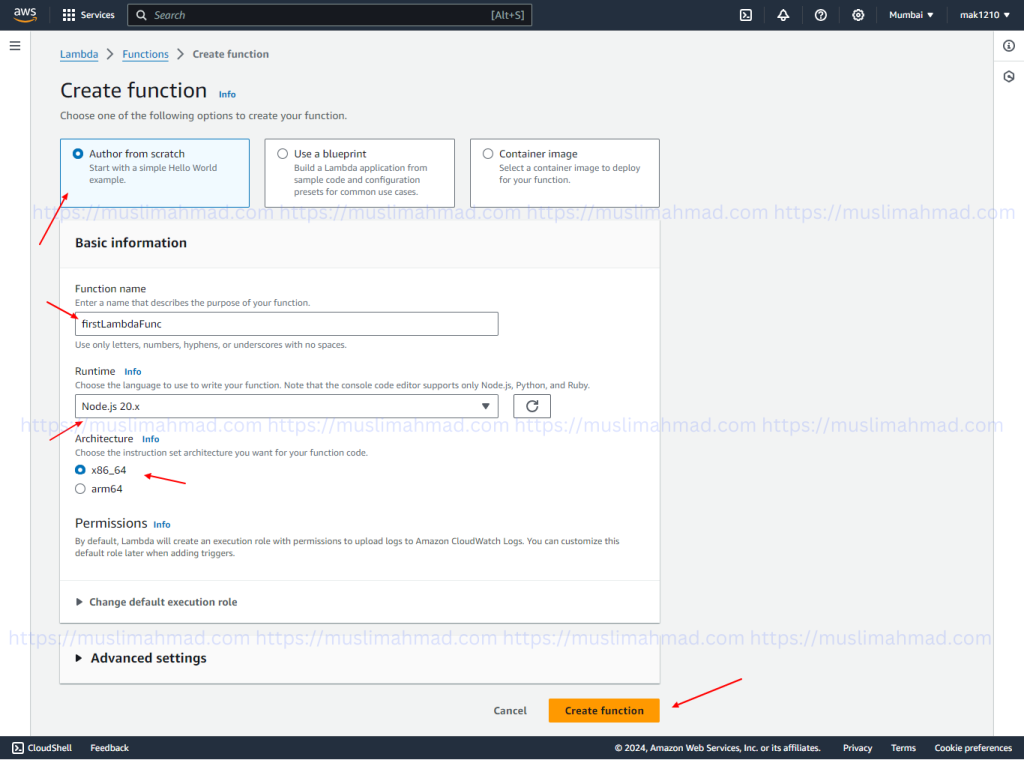
Here, we can select “Author from scratch” and provide basic information about the function:
a. Function Name: ‘firstLambdafunc’ (you can choose your own name).
b. Runtime (tech stack): ‘Node.js 20.x’
c. Architecture: ‘x86_64’
Leave the rest of the options as they are, and click on the ‘Create function’ button to complete the process.

Congrats!
You have now created your first Lambda function in the AWS Console. You can see from the above image that the function was created successfully. You can check the code in the index.mjs file within the ‘firstLambdaFunc’ folder.
Note: .mjs is a file extension for JavaScript modules that use the ECMAScript Modules (ESM) specification. ECMAScript modules are part of the JavaScript language standard and provide a more modern and standardized way to define modules.
export const handler = async (event) => {
// TODO implement
const response = {
statusCode: 200,
body: JSON.stringify('Hello from Lambda!'),
};
return response;
};
The above code is the default code for the Node.js runtime (tech stack) for a Lambda function. We can modify this code according to our requirements to solve various problems and create applications ranging from small to enterprise-level.
Step 2: Write the Function Code
In the Lambda console, replace the default code with the modified code below:
export const handler = async (event) => {
// TODO implement
const response = {
statusCode: 200,
body: JSON.stringify('Hello from Muslim Ahmad - Serverless Lambda Function!'),
};
return response;
};

You can follow the same process as shown in the above image and click on the ‘Deploy’ button to update the Lambda function.
Now, you can check that the code has been updated in the Lambda function in the image below:

Now, the question arises: how can we check the result of this Lambda function? We can use a trigger to check the result. There are many triggers to choose from in the Lambda AWS Trigger configuration, but we will use ‘API Gateway’ to create an endpoint for retrieving the result data.
Step 3: Configure a Trigger
Add a Trigger: To add a trigger, click on the ‘+ Add trigger’ button, as shown in the image below:
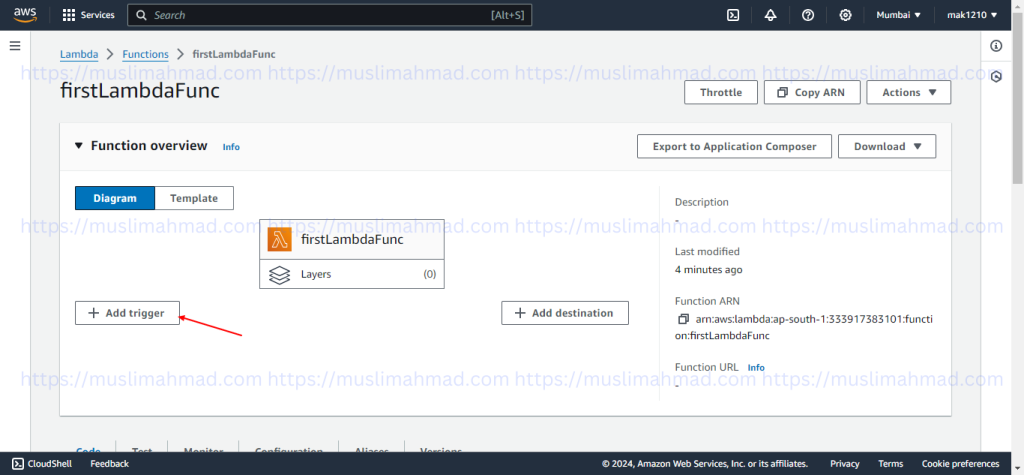
Now, the ‘Add trigger’ page is open for configuring the trigger. You can choose the trigger according to your needs, but in this case, we will select API Gateway:

After choosing API Gateway, additional options will open for further configurations, as shown in the image below:

Trigger Configuration Option List:
- Trigger: ‘API Gateway’
- Intent: This option allows you to choose the API setup for a new or existing API. We can select ‘Create a new API’ for a new one.
- API Type: ‘Rest API’ (more details)
- Security: Open (for now)
Leave the rest of the options as they are and click the ‘Add’ button to proceed.
Now, you can check that the ‘API Gateway‘ trigger has been added to the Lambda function and that an API endpoint has been created for you in the API Gateway.
https://7vn0c7pwe3.execute-api.ap-south-1.amazonaws.com/default/firstLambdaFunc
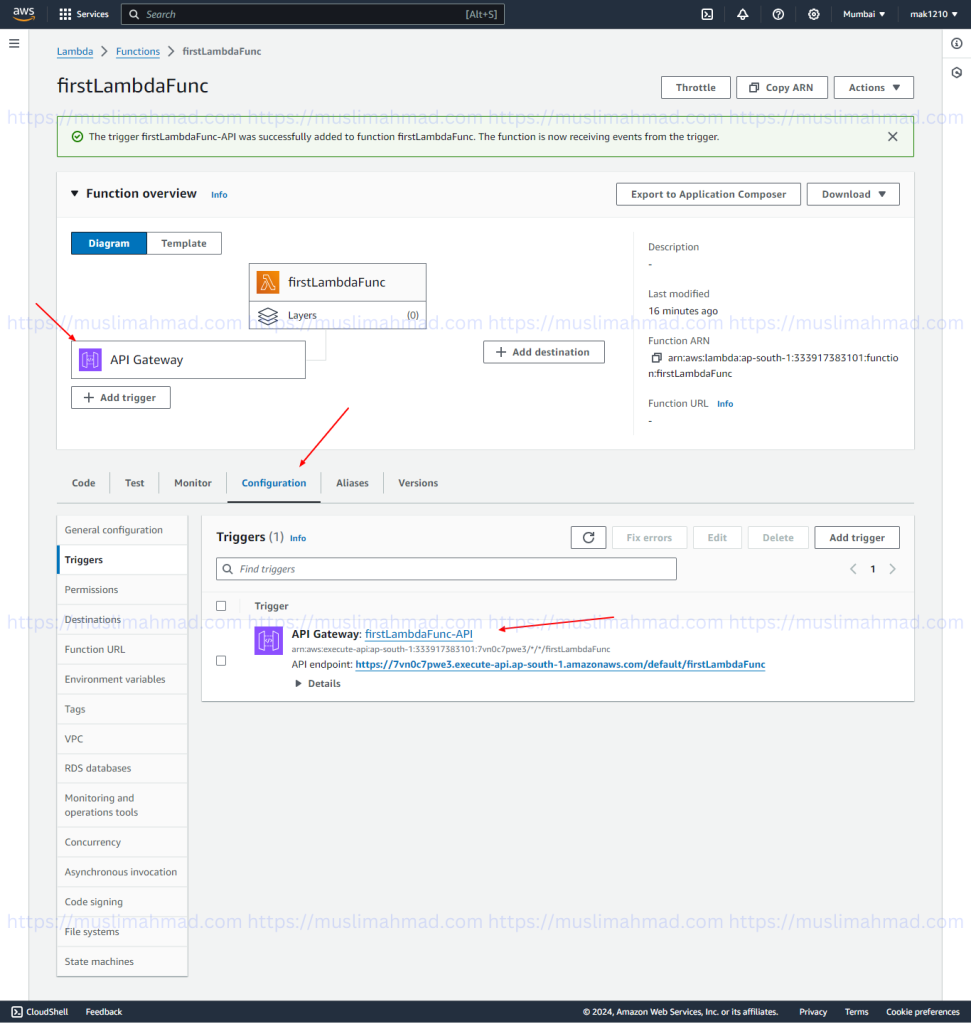
Step 4: Test the Function
We will test the endpoint in two ways:
1. Directly in the Browser: Open your browser and enter the URL of the API endpoint to see the result directly:
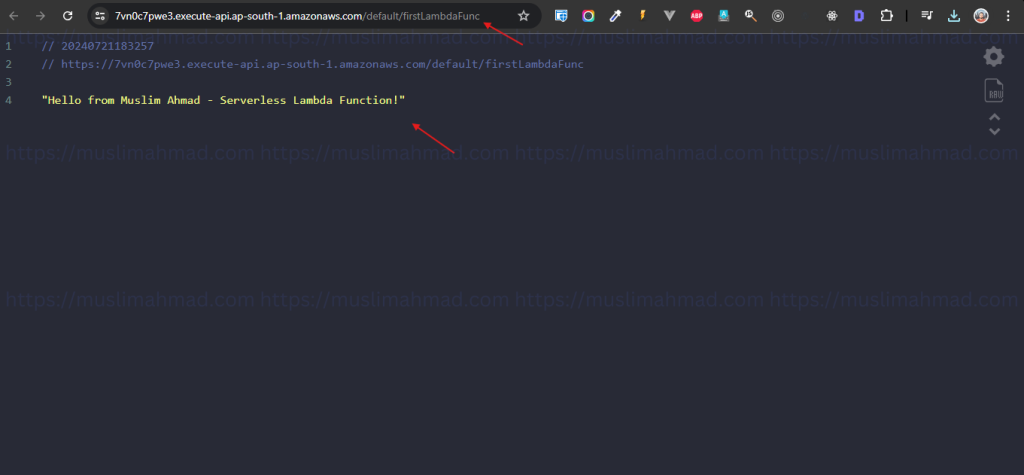
2. Using the Postman App: Open the Postman app, create a new GET request, and enter the URL of the API endpoint to test and view the result:

Step 4: Modify the Code of the Function
Now, you can update the code in the index.mjs file according to our scenario:
const handler = async (event) => {
// TODO implement
const response = {
statusCode: 200,
headers: {
'Content-Type': 'application/json',
},
body: JSON.stringify({
message: 'Hello from Muslim Ahmad - Serverless Lambda Function!',
}),
};
return response;
};
In this code:
- We have added the header ‘Content-Type’: ‘application/json’ to ensure the result is shown in JSON format.
- The response body is a JSON object with a message field containing the string ‘Hello from Muslim Ahmad – Serverless Lambda Function!’.
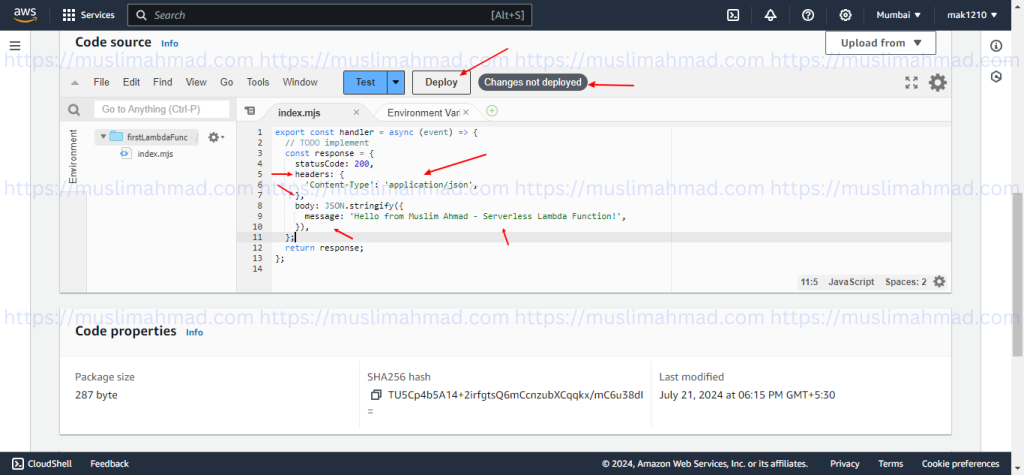
Result: You can see that the result string ‘Hello from Muslim Ahmad – Serverless Lambda Function!’ is placed in the message key of the JSON response
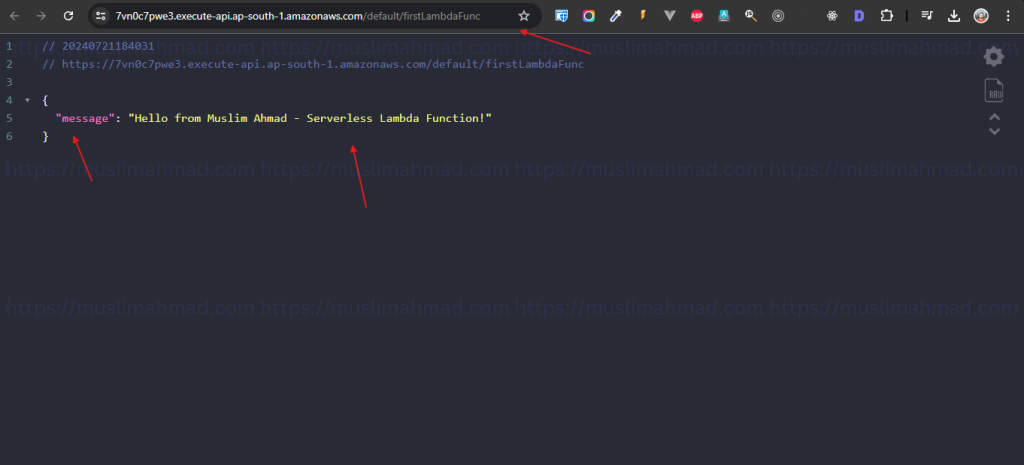
Postman:
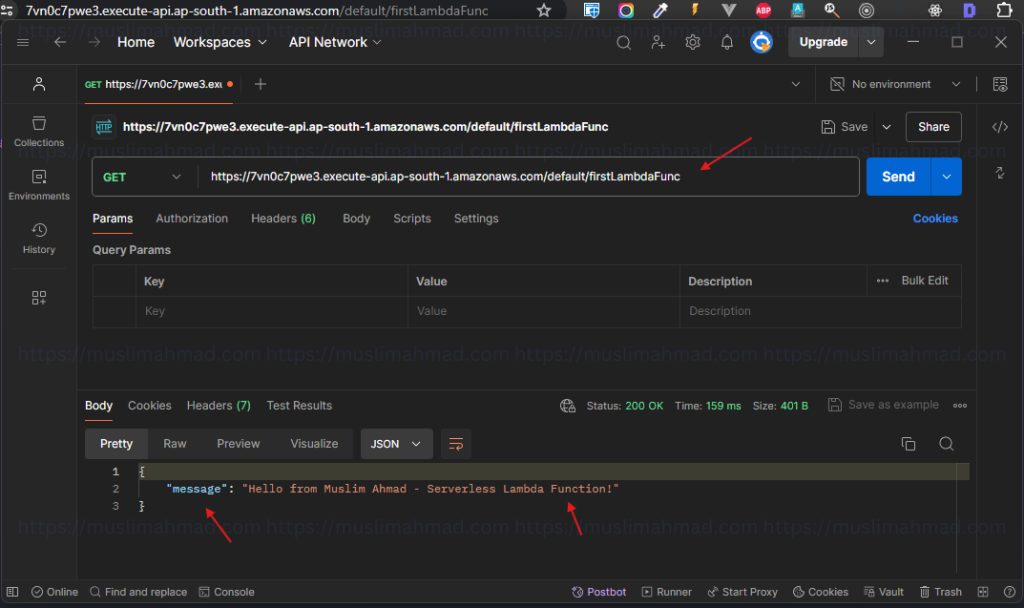
Note: Please be aware that if you leave any AWS services running, they may generate charges on your account. To avoid unexpected billing, make sure to stop or delete any unused resources.
Startup MVP Product Setup:
If you want to set up an MVP product for your startup company and need to build it quickly, learn how to build your first application. (more details).
In the future, there will be many blogs on setting up real-world applications, so stay tuned and subscribe to my blog to receive notifications about new posts.
Serverless AWS Lambda Pricing
As of July 2024, AWS Lambda pricing involves several components, mainly based on compute time, memory allocation, and the number of requests. Here’s a detailed breakdown:
Compute Pricing
- Free Tier: 400,000 GB-seconds of compute time per month.
- Beyond Free Tier: $0.0000166667 per GB-second.
Request Pricing
- Free Tier: 1 million requests per month.
- Beyond Free Tier: $0.20 per 1 million requests.
Additional Pricing Factors
- Provisioned Concurrency: Charges for keeping functions initialized for low-latency responses. The pricing depends on the amount of memory and the concurrency level configured.
- Ephemeral Storage: For functions requiring additional storage beyond the default 512 MB, the cost is $0.0000000309 per GB-second.
Example Cost Calculation
For a function with 1 GB of memory, executed 3 million times in a month, the cost would be:
- Request Charges: 2 million requests beyond the free tier, totaling $0.40.
- Compute Charges: Assuming an average execution time of 100ms, the compute duration would be approximately 300,000 seconds. This equals 300,000 GB-seconds, costing around $5.00.
Optimizing Costs
To manage and optimize AWS Lambda costs, consider the following strategies:
- Optimize Execution Time: Refactor code to reduce execution duration.
- Adjust Memory Allocation: Fine-tune memory settings to balance cost and performance.
- Efficient Triggers: Minimize unnecessary function invocations.
- Utilize Free Tier: Especially beneficial for small-scale applications or during the development phase.
For a more detailed and up-to-date breakdown of AWS Lambda pricing, you can visit the official AWS pricing page here.
Prominent AWS Lambda Forums and Communities
AWS Lambda is an integral part of the serverless computing ecosystem, and there is a wealth of knowledge shared within various forums and communities. These platforms offer a space for developers to ask questions, share best practices, and discuss the latest features and updates. Below, we’ll delve into some of the most prominent forums and communities dedicated to AWS Lambda, as well as tips on how to effectively use these resources.
1. AWS Developer Forums
The AWS Developer Forums provide a platform for AWS users to discuss various AWS services, including AWS Lambda. Here, you can find threads on troubleshooting, best practices, and new feature announcements.
Key Features:
- Dedicated Lambda Forum: A specific section for AWS Lambda-related queries.
- Community Support: Engage with AWS experts and fellow developers.
- Searchable Archives: Access to a rich history of discussions and solutions.
Link: AWS Lambda Forum
2. Stack Overflow
Stack Overflow is a popular Q&A site where developers can ask and answer questions on a wide range of topics, including AWS Lambda. It’s a great place to find solutions to common problems and share your expertise.
Key Features:
- Tagging System: Use the aws-lambda tag to filter relevant questions and answers.
- Community Voting: Upvote and downvote answers to highlight the most useful solutions.
- Reputation Building: Earn reputation points by contributing high-quality questions and answers.
Link: AWS Lambda on Stack Overflow
3. Reddit
Reddit hosts several subreddits dedicated to AWS and serverless computing, including AWS Lambda. These communities are great for discussions, sharing news, and getting quick advice.
Key Features:
- r/aws: A subreddit focused on all things AWS, including Lambda.
- r/serverless: A subreddit specifically for serverless technologies, including AWS Lambda.
- Community Discussions: Participate in in-depth discussions and stay updated with the latest trends.
Links:
4. GitHub
GitHub is not just for code repositories; it also has an active community discussing AWS Lambda issues, features, and enhancements. Many open-source Lambda projects and libraries are hosted on GitHub.
Key Features:
- Issue Tracking: Report bugs and request features for Lambda-related projects.
- Collaborative Development: Contribute to and fork Lambda-related repositories.
- Discussions: Engage in discussions within the issues and pull requests sections.
Link: AWS Lambda on GitHub
5. AWS re
AWS re is a cloud knowledge service that connects you with community experts to answer your AWS-related questions. It is integrated with the AWS Management Console, making it easy to ask questions directly from the AWS environment.
Key Features:
- Expert Answers: Get responses from AWS experts and certified professionals.
- Integration with AWS Console: Ask questions directly from the AWS Management Console.
- Reputation System: Earn reputation points for contributing quality answers.
Link: AWS re
AWS Lambda Official Documentation
AWS Lambda’s official documentation is a comprehensive resource that provides detailed information about the service. It covers everything from getting started to advanced topics, making it an essential guide for both beginners and experienced users. Below is an overview of the key sections and features of the AWS Lambda documentation.
Click here for more details: AWS Lambda documentation & AWS Lambda Function.
Best Practices for AWS Lambda with Node.js
1. Optimize Performance
- Minimize Cold Starts: Keep your functions warm using scheduled invocations.
- Efficient Memory Allocation: Allocate memory based on performance requirements and monitor usage.
- Reduce Package Size: Use the smallest possible deployment package to enhance performance.
2. Handle Errors Gracefully
- Logging: Utilize CloudWatch Logs for tracking and debugging.
- Retries: Configure retry policies for handling transient failures.
- Timeouts: Set appropriate timeout values to avoid prolonged execution.
3. Secure Your Functions
- Least Privilege Principle: Assign minimal necessary permissions to Lambda execution roles.
- Environment Variables: Store sensitive data in encrypted environment variables using AWS KMS.
- VPC Security: If needed, run your functions inside a VPC for enhanced security.
Conclusion
AWS Lambda, combined with Node.js, offers a robust, scalable, and cost-efficient platform for building serverless applications. Triggers are a powerful feature of AWS Lambda, enabling you to build highly responsive and scalable applications. By understanding the different types of triggers and how to configure them, you can create robust event-driven architectures that leverage the full potential of AWS Lambda.
AWS Lambda’s versatility makes it a powerful tool for various use cases, from real-time data processing to automating backend tasks. By understanding these use cases and implementing Lambda functions effectively, you can build scalable, cost-efficient, and responsive applications that meet a wide range of requirements. Embrace the serverless revolution with AWS Lambda and unlock new possibilities for your projects.
AWS Lambda forums and communities are invaluable resources for developers looking to leverage the power of serverless computing. Whether you’re troubleshooting an issue, seeking best practices, or staying updated with the latest developments, AWS Lambda forums and communities platforms provide a wealth of knowledge and support. Engage with these communities to enhance your AWS Lambda skills and connect with fellow developers around the world.
By following this guide, you can create and optimize Lambda functions to meet your application needs while adhering to best practices for performance, error handling, and security.
Note: Please be aware that if you leave any AWS services running, they may generate charges on your account. To avoid unexpected billing, make sure to stop or delete any unused resources.
🕵️☔ Vercel vs Netlify vs Heroku vs Render 🌧️🌐- Serverless Ecosystem 💥🌩️ – Best & Free in 2024 – #20
🤔 Will AI eat jobs 🤤 v0.dev Vercel Revolution – Free AI Tool 😭⍩⃝ – #19
👨🏻💻 How to use v0.dev Vercel – Free Revolutionizing AI Tool 🎉🤩 – #18

